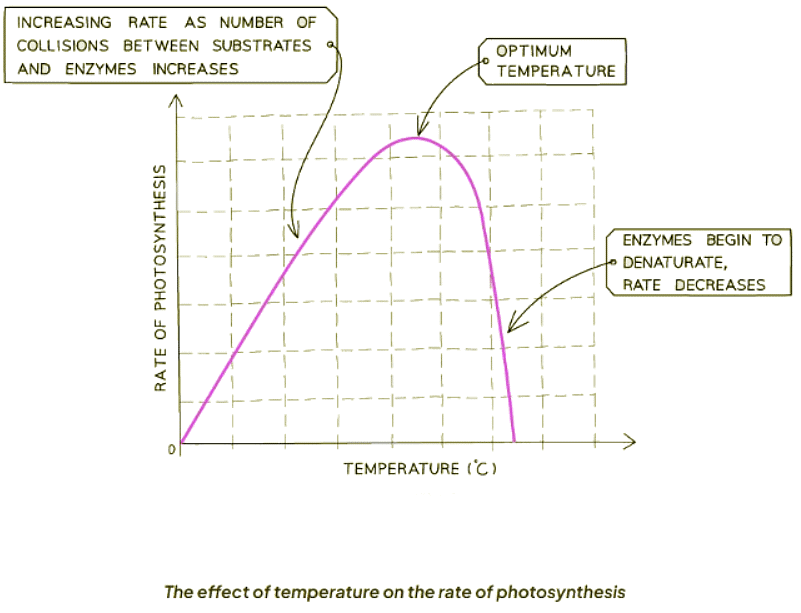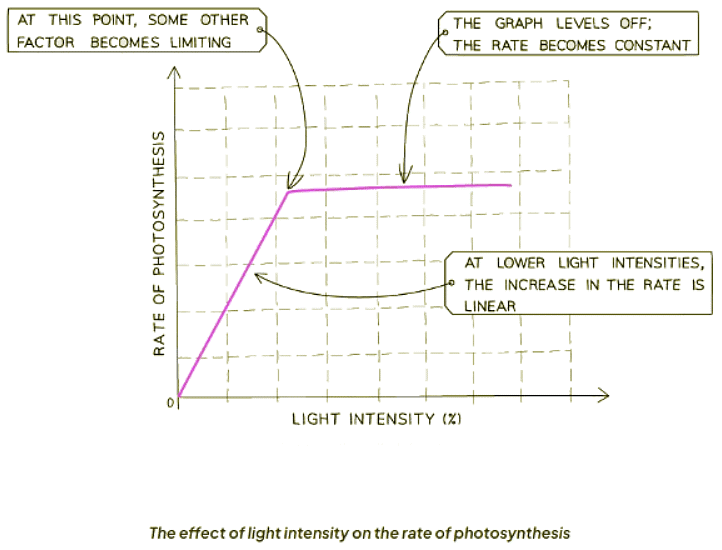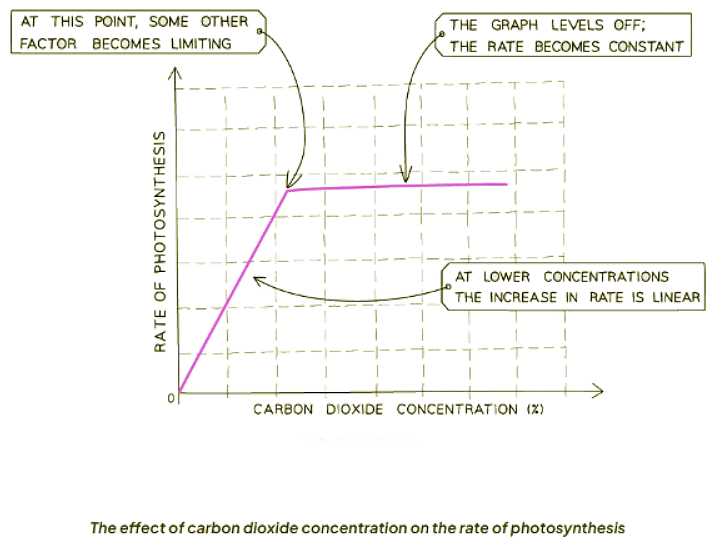Class 10 Exam > Class 10 Notes > Biology for GCSE/IGCSE > Limiting Factors
Limiting Factors | Biology for GCSE/IGCSE - Class 10 PDF Download
Limiting Factors: Extended
- When plants have an abundance of sunlight, carbon dioxide, and water, their rate of photosynthesis is primarily constrained by their capacity to absorb and utilize these resources effectively.
- However, in natural conditions, plants often face limitations in one or more of these essential resources, leading to a constrained rate of photosynthesis determined by the factor that is most scarce.
- A limiting factor refers to an environmental component that is in insufficient supply, thereby impeding vital life processes.
- The rate of photosynthesis can be restricted by three primary factors:
- Temperature
- Light intensity
- Carbon dioxide concentration
- Although water is indispensable for photosynthesis, it is seldom a limiting factor due to the relatively small quantity required compared to the volume of water transpired by a plant, ensuring an ample supply for photosynthetic processes under most circumstances.
Question for Limiting FactorsTry yourself: Which of the following factors can limit the rate of photosynthesis in plants?View Solution
Temperature
- Elevated temperatures typically enhance the rate of photosynthesis because enzymatic reactions driving the process become more efficient.
- Nevertheless, this pattern is limited by the susceptibility of enzymes to denaturation at higher temperatures, causing a decline in the rate of reaction beyond a certain threshold.

Light intensity
- Increased light intensity generally correlates with a higher rate of photosynthesis in plants.
- However, this relationship persists only until another limiting factor, such as the availability of carbon dioxide or optimal temperature, constrains further increases in the rate of photosynthesis.

- When light intensity is low, augmenting it initially boosts the rate of photosynthesis. However, there's a threshold beyond which further increases in light intensity no longer enhance the rate. At this point, another factor becomes the limiting factor.
- Factors like insufficient temperature or inadequate carbon dioxide levels might limit the rate when the graph line levels off.
Carbon dioxide concentration
- Carbon dioxide is essential for photosynthesis, serving as one of its raw materials.
- Consequently, higher concentrations of carbon dioxide facilitate a faster reaction rate.
- This pattern persists until the rate plateaus due to the limitation imposed by another factor essential for photosynthesis, which becomes scarce.

- When the line on the graph remains horizontal, it suggests that factors like insufficient temperature or inadequate light could be constraining the rate.
The document Limiting Factors | Biology for GCSE/IGCSE - Class 10 is a part of the Class 10 Course Biology for GCSE/IGCSE.
All you need of Class 10 at this link: Class 10
|
110 videos|210 docs|33 tests
|
FAQs on Limiting Factors - Biology for GCSE/IGCSE - Class 10
| 1. What are limiting factors in an ecosystem? |  |
Ans. Limiting factors in an ecosystem are environmental conditions that limit the growth, abundance, or distribution of an organism or a population within an ecosystem. These factors can include resources like food, water, shelter, and space, as well as factors like predation, competition, and disease.
| 2. How do limiting factors affect population growth? |  |
Ans. Limiting factors can directly impact population growth by restricting the availability of essential resources or by increasing mortality rates. When a population reaches the carrying capacity of its environment, limiting factors play a crucial role in regulating the size of the population and preventing it from exceeding the ecosystem's capacity to support it.
| 3. Can limiting factors change over time in an ecosystem? |  |
Ans. Yes, limiting factors can change over time in an ecosystem due to various factors such as natural disasters, climate change, human activities, and species interactions. These changes can alter the availability of resources and impact the balance of populations within the ecosystem.
| 4. How do human activities contribute to limiting factors in ecosystems? |  |
Ans. Human activities such as deforestation, pollution, overfishing, and habitat destruction can create or intensify limiting factors in ecosystems. These activities can disrupt the natural balance of resources, leading to a decline in biodiversity and impacting the overall health of the ecosystem.
| 5. What strategies can be implemented to mitigate the effects of limiting factors in ecosystems? |  |
Ans. Conservation efforts, sustainable resource management, habitat restoration, and biodiversity preservation are some strategies that can help mitigate the effects of limiting factors in ecosystems. By promoting ecosystem resilience and reducing human impacts, these strategies can help maintain the balance of populations and promote overall ecosystem health.
Related Searches















